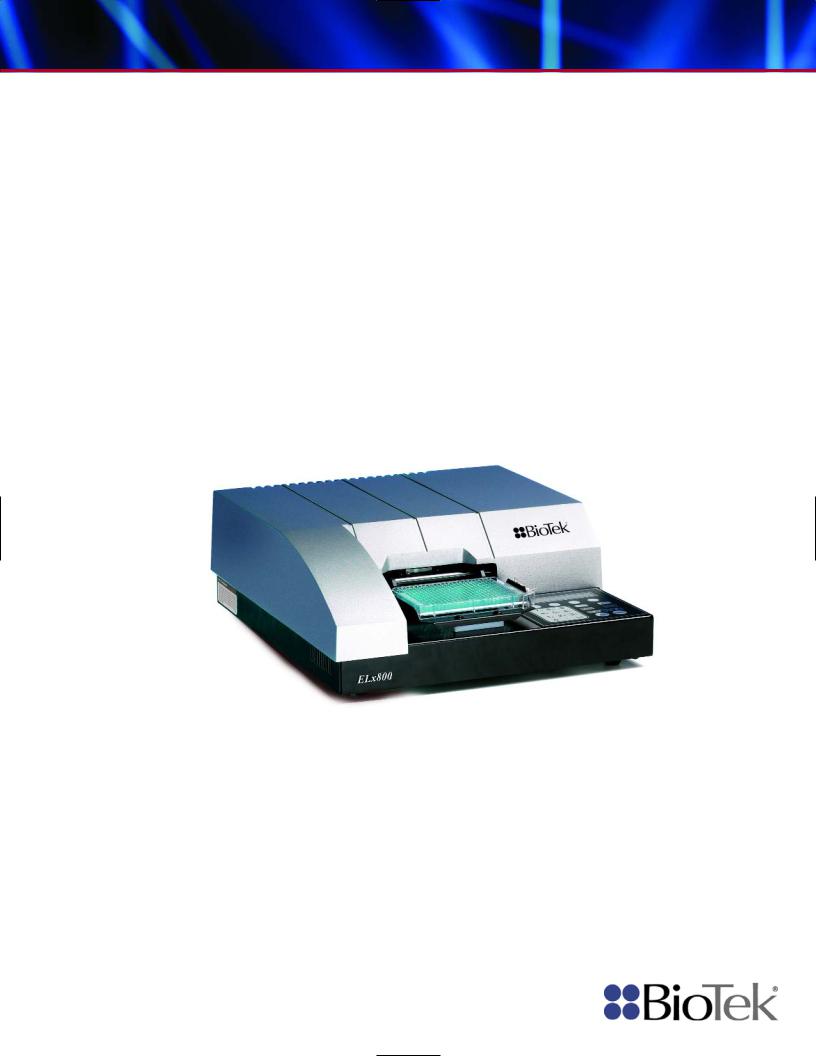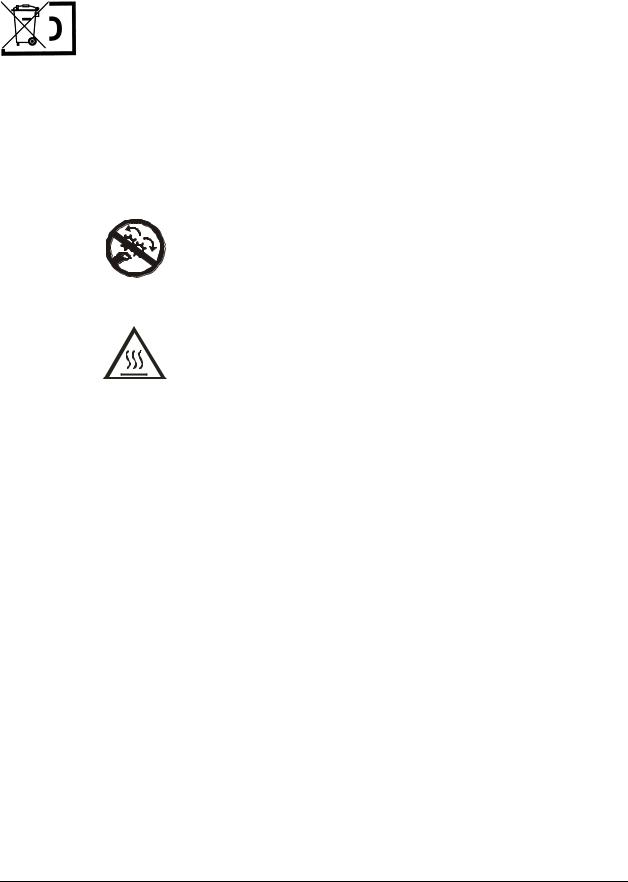Biotek ELx800 User manual

Absorbance Microplate Reader
ELx800™
Operator’s Manual
.

7331000 Rev P1
This Manual Update contains changes to the ELx800™ Absorbance Microplate Reader Operator’s Manual. These changes will be incorporated in the next full revision of the manual, revision Q.
Replacing and Aligning the Bulb
Chapter 5, Maintenance and Decontamination contains instructions for replacing and aligning the bulb. These instructions do not contain enough information to help you properly align the bulb in all cases.
When it becomes necessary to replace the bulb*, replacement kits are available from BioTek. PN 7330513 is required for standard models, and PN 7330516 is required for ELx800UV and ELx800NB models. The kit contains complete instructions for replacing and aligning the bulb. Please ignore the replacement/alignment instructions currently supplied in this manual in Chapter 5.
If you have any questions or require further assistance, please contact BioTek’s Technical Assistance Center (TAC). Contact information is provided on page x.
* The lamp is rated for an average life of 600 hours. The intensity of the lamp will slowly drop over time until the run-time self check detects a low signal level. The reader will display an error code at this time, indicating that it is time to replace the bulb.
© 2006, BioTek Instruments, Inc. |
Page 1 of 1 |
.

ELx800™
Absorbance Microplate Reader
Operator’s Manual
October 2006 © 2006
Part Number 7331000 Revision P
BioTek® Instruments, Inc.

ii | Preface
Notices
BioTek® Instruments, Inc.
Highland Park, P.O. Box 998
Winooski, Vermont 05404-0998 USA
All Rights Reserved
© 2006, BioTek® Instruments, Incorporated. No part of this publication may be reproduced, transcribed, or transmitted in any form, or by any means electronic or mechanical, including photocopying and recording, for any purpose other than the purchaser’s use without written permission of BioTek Instruments, Inc.
Trademarks
BioTek® is a registered trademark, and ELx800™, Gen5™, KC4™, KCjunior™, and EL800™ are trademarks of BioTek Instruments, Inc. Microsoft®, Windows®, and the Windows logo are registered trademarks of Microsoft Corporation in the United States and other countries. All other trademarks are the property of their respective holders.
Restrictions and Liabilities
Information in this document is subject to change and does not represent a commitment by BioTek Instruments, Inc. Changes made to the information in this document will be incorporated in new editions of the publication. No responsibility is assumed by BioTek for the use or reliability of software or equipment that is not supplied by BioTek or its affiliated dealers.
BioTek Instruments, Inc.

Contents |
| iii |
Contents |
|
Notices ............................................................................................. |
ii |
All Rights Reserved ................................................................................. |
ii |
Trademarks ........................................................................................... |
ii |
Restrictions and Liabilities........................................................................ |
ii |
Contact Information .................................................................................. |
x |
Customer Service and Sales ..................................................................... |
x |
Service/TAC........................................................................................... |
x |
European Coordination Center .................................................................. |
x |
Document Conventions ............................................................................. |
xi |
Revision History....................................................................................... |
xii |
Intended Use Statement .......................................................................... |
xv |
Quality Control ....................................................................................... |
xv |
Repackaging and Shipping........................................................................ |
xv |
Warnings ............................................................................................... |
xvi |
Hazards and Precautions .......................................................................... |
xvi |
Hazards............................................................................................... |
xvi |
Precautions......................................................................................... |
xvii |
Directive 89/336/EEC:Electromagnetic Compatibility.................................. |
xix |
Directive 73/23/EEC Low Voltage ............................................................ |
xix |
Directive 2002/96/EC: Waste Electrical and Electronic Equipment ................ |
xix |
Directive 98/79/EC: In Vitro Diagnostics .................................................. |
xix |
Electromagnetic Interference and Susceptibility........................................... |
xx |
User Safety ............................................................................................ |
xx |
Safety Symbols....................................................................................... |
xxi |
Chapter 1: Introduction.................................................................... |
1 |
Introducing the ELx800 Absorbance Microplate Reader ................................... |
2 |
Hardware Features .................................................................................... |
3 |
Software Features ..................................................................................... |
3 |
Package Contents ..................................................................................... |
4 |
Optional Accessories.................................................................................. |
5 |
Specifications ........................................................................................... |
6 |
ELx800 Operator's Manual

iv | Preface |
|
Standard Model ...................................................................................... |
6 |
Ultraviolet/UV Model ............................................................................... |
7 |
Narrow Beam/NB Model........................................................................... |
8 |
Product Support & Service........................................................................ |
10 |
Contacting the Technical Assistance Center .............................................. |
10 |
Returning Instruments for Service/Repair................................................. |
10 |
Chapter 2: Installation ................................................................... |
11 |
Unpacking and Inspecting the ELx800™ ..................................................... |
12 |
Unpacking the Instrument and Its Accessories .......................................... |
13 |
Setting Up the ELx800 ............................................................................. |
17 |
Operating Environment.......................................................................... |
17 |
Electrical Connections............................................................................ |
17 |
Power-Up and System Test .................................................................... |
18 |
ELx800 Main Menu................................................................................ |
18 |
Configuring Global Default Options .......................................................... |
19 |
Connecting a Printer to the ELx800 ......................................................... |
20 |
Setting Up the Serial Port for Communications With Other Devices................. |
22 |
Attaching the Cable............................................................................... |
22 |
Installing Software on the Host PC .......................................................... |
22 |
Setting Communication Parameters......................................................... |
22 |
Installing Additional Filters ....................................................................... |
24 |
Checking the Reader’s Filter Table Setting................................................ |
26 |
Repackaging and Shipping the ELx800 ....................................................... |
28 |
Before Repackaging the Instrument......................................................... |
28 |
Repackaging the ELx800 and Its Accessories ............................................ |
29 |
Preparing the Shipping Container ............................................................ |
35 |
Chapter 3: Operation ...................................................................... |
37 |
ELx800 Front Panel ................................................................................. |
38 |
Overview ............................................................................................... |
40 |
Recommendations for Achieving Optimum Performance................................ |
40 |
System Startup ...................................................................................... |
41 |
Main Menu ............................................................................................. |
42 |
Define ................................................................................................... |
44 |
BioTek Instruments, Inc.

|
Contents | v |
Programming Note................................................................................ |
45 |
Selecting an Assay to Define .................................................................. |
46 |
Editing the Assay Name ......................................................................... |
46 |
Define (Method, Map, Formula and Curve).................................................. |
47 |
Defining METHOD ................................................................................. |
47 |
Defining MAP ....................................................................................... |
51 |
Defining FORMULA ................................................................................ |
67 |
Defining CURVE .................................................................................... |
79 |
Reading a Microplate ............................................................................... |
86 |
Selecting an Assay to Run...................................................................... |
87 |
Printing Reports ...................................................................................... |
91 |
Editing Standard Outliers ....................................................................... |
92 |
Printing Results .................................................................................... |
94 |
Using the Utility Options........................................................................... |
95 |
Setting the Date and Time ..................................................................... |
95 |
Viewing/Editing the Filter Table............................................................... |
96 |
Specifying Data Output and Reporting Options.......................................... |
97 |
Selecting Read Options.......................................................................... |
99 |
Chapter 4: Instrument Qualification ............................................. |
101 |
Recommendations for Achieving Optimum Performance.............................. |
102 |
Recommended Qualification Schedule ...................................................... |
103 |
Qualification Procedures......................................................................... |
104 |
System Test....................................................................................... |
105 |
Checksum Test................................................................................... |
107 |
Absorbance Plate Test ......................................................................... |
108 |
Description ..................................................................................... |
108 |
Requirements.................................................................................. |
110 |
Defining the Absorbance Test Plate Parameters.................................... |
111 |
Running the Absorbance Plate Test..................................................... |
112 |
Test Failures ................................................................................... |
113 |
Liquid Testing ....................................................................................... |
114 |
Stock Solution Formulation .................................................................. |
115 |
Liquid Test 1 ...................................................................................... |
117 |
ELx800 Operator's Manual

vi | Preface |
|
Liquid Test 2 ...................................................................................... |
119 |
Liquid Test 3 (for “UV” Models Only)...................................................... |
123 |
Chapter 5: Maintenance and Decontamination ............................. |
127 |
Maintenance......................................................................................... |
128 |
Routine Cleaning Procedure .................................................................... |
128 |
Purpose............................................................................................. |
128 |
Tools and Supplies .............................................................................. |
129 |
Procedure .......................................................................................... |
129 |
Replacing the Bulb ................................................................................ |
130 |
Decontamination Procedure .................................................................... |
133 |
Tools and Supplies .............................................................................. |
134 |
Procedure .......................................................................................... |
134 |
Chapter 6: Troubleshooting and Error Codes ................................ |
137 |
Overview ............................................................................................. |
138 |
System Test Description......................................................................... |
138 |
Glossary of Terms............................................................................... |
138 |
Error Codes.......................................................................................... |
139 |
General Errors.................................................................................... |
140 |
Fatal Errors........................................................................................ |
146 |
Appendix A: Computer Control ..................................................... |
147 |
Overview ............................................................................................. |
148 |
Controlling the Reader With Gen5™ ......................................................... |
149 |
Setting Up Gen5 ................................................................................. |
149 |
Problems ........................................................................................... |
150 |
Getting Started With Gen5 ................................................................... |
150 |
Controlling the Reader With KC4™........................................................... |
152 |
Setting Up KC4................................................................................... |
152 |
Problems ........................................................................................... |
153 |
Getting Started With KC4™ .................................................................. |
153 |
Controlling the Reader With KCjunior™ .................................................... |
154 |
Setting Up KCjunior ............................................................................ |
154 |
Problems ........................................................................................... |
155 |
BioTek Instruments, Inc.

Contents |
| vii |
Getting Started With KCjunior™............................................................ |
155 |
Appendix B: Using 384-Well Geometry ......................................... |
157 |
Perform a 384-Well Plate Read in Gen5™ ................................................. |
158 |
Perform a 384-Well Plate Read in KC4™ ................................................... |
162 |
Perform a 384-Well Plate Read in KCjunior™............................................. |
165 |
Appendix C: Report Format........................................................... |
169 |
Appendix D: Comparison of the ELx800 and the EL800................. |
177 |
Appendix E: Instructions for Programming a New Assay.............. |
179 |
Sample ANA Screen Enzyme Immunoassay Kit.......................................... |
180 |
Intended Use ..................................................................................... |
180 |
Background ....................................................................................... |
180 |
Principle of the Assay .......................................................................... |
180 |
Materials ........................................................................................... |
181 |
Quality Control and Results .................................................................. |
182 |
Expected Values ................................................................................. |
182 |
Programming the ANA Screen Enzyme Immunoassay Kit ............................ |
183 |
Sample Human Anticardiolipin IgG Enzyme Immunoassay Kit...................... |
185 |
Intended Use ..................................................................................... |
185 |
Background ....................................................................................... |
185 |
Principle of the Assay .......................................................................... |
185 |
Materials ........................................................................................... |
186 |
Quality Control and Results .................................................................. |
187 |
Expected Values ................................................................................. |
189 |
Programming the Human Anticardiolipin IgG Enzyme Immunoassay Kit ........ |
190 |
ELx800 Operator's Manual

viii | Preface |
|
List of Figures |
|
Figure 1: Removing the Power Supply and Shelf..................................... |
13 |
Figure 2: Removing the Foam End Caps................................................ |
14 |
Figure 3: Removing the Top Cover Mounting Screws............................... |
15 |
Figure 4: Removing the Shipping Block ................................................. |
16 |
Figure 5: Global Configuration Options Available Under UTIL.................... |
19 |
Figure 6: Connectors for Printer (Parallel), Computer (Serial), and Power |
|
Supply ........................................................................................ |
21 |
Figure 7: Filter Wheel Assembly........................................................... |
24 |
Figure 8: Securing the Carrier ............................................................. |
29 |
Figure 9: Hooking the Shipping Straps Over the Post .............................. |
30 |
Figure 10: Installing the Shipping Block ................................................ |
31 |
Figure 11: Reinstalling the Top Cover ................................................... |
32 |
Figure 12: Reattaching the End Caps .................................................... |
33 |
Figure 13: Placing the Unit in the Box ................................................... |
34 |
Figure 14: Keyboard .......................................................................... |
38 |
Figure 15: Options Available from the Main Menu ................................... |
42 |
Figure 16: Sample Output for the System Test (Sheet 1 of 2) ................ |
106 |
Figure 17: Sample Output for the System Test – Autocal Analysis |
|
(Sheet 2 of 2) ............................................................................ |
107 |
Figure 18: Sample Standards Certificate for the Absorbance Test Plate.... |
111 |
Figure 19: Sample Test Plate Analysis Report ...................................... |
111 |
Figure 20: Lamp Assembly................................................................ |
133 |
Figure 21: Reader Configuration Dialog............................................... |
160 |
Figure 22: Reader Settings Dialog ...................................................... |
160 |
Figure 23: New Experiment Dialog ..................................................... |
161 |
Figure 24: Experiment Workspace...................................................... |
161 |
Figure 25: Procedure Dialog .............................................................. |
162 |
Figure 26: Read Step Dialog.............................................................. |
162 |
Figure 27: Plate Reading Dialog ......................................................... |
163 |
Figure 28: KC4 Main Menu, System|Readers........................................ |
164 |
Figure 29: Reader Selection Dialog..................................................... |
164 |
Figure 30: New Data File Dialog......................................................... |
165 |
BioTek Instruments, Inc.

List of Figures (Continued) |
| ix |
List of Figures (Continued) |
|
Figure 31: Reading Dialog.................................................................... |
165 |
Figure 32: Plate Reading Dialog ............................................................ |
166 |
Figure 33: Setup|Reader Dialog ............................................................ |
167 |
Figure 34: Reader Setup Dialog ............................................................ |
167 |
Figure 35: Read Plate Dialog ................................................................ |
168 |
Figure 36: Protocol Definition Dialog...................................................... |
168 |
Figure 37: Example Read Method Parameters ......................................... |
169 |
Figure 38: Samples With Calls on Matrix Report ...................................... |
172 |
Figure 39: Curve Fit Report .................................................................. |
173 |
Figure 40: Samples With Calls on Column Report .................................... |
174 |
Figure 41: Column Report Without Samples............................................ |
175 |
Figure 42: Panel Report ....................................................................... |
176 |
Figure 43: Assay Detail Report (Sheet 1 of 2) ......................................... |
177 |
Figure 44: Assay Detail Report (Sheet 2 of 2) ......................................... |
178 |
List of Tables |
|
Table 1: Recommended Qualification Schedule........................................ |
103 |
Table 2: Typical Enzyme-Substrate Combinations and Stopping Solutions ... |
115 |
Table 3: Test Tube Dilutions................................................................. |
120 |
Table 4: PBS 10X Concentrate Solution.................................................. |
125 |
ELx800 Operator's Manual

x | Preface
Contact Information
BioTek® Instruments, Inc.
Highland Park, P.O. Box 998
Winooski, Vermont 05404-0998 USA
Customer Service and Sales
Internet: |
www.biotek.com |
Phone: |
888-451-5171 (toll free in the U.S.) |
|
802-655-4740 (outside the U.S.) |
Fax: |
802-655-7941 |
E-Mail: |
customercare@biotek.com |
Service/TAC
Phone: |
800-242-4685 (toll free in the U.S.) |
|
802-655-4740 (outside the U.S.) |
Fax: |
802-655-3399 |
E-Mail: |
tac@biotek.com |
European Coordination Center
BioTek® Instruments GmbH
Kocherwaldstrasse 34
D-74177 Bad Friedrichshall
Germany |
|
|
|
Internet: |
www.biotek.de |
||
Phone: |
+49 |
(0) |
7136 9680 |
Fax: |
+49 |
(0) |
7136 968 111 |
E-Mail: |
info@biotek.de |
||
BioTek Instruments, Inc.

Document Conventions | xi
Document Conventions
This manual uses the following typographic conventions:
Example |
Description |
|
|
|
This icon calls attention to important safety notes. |
Warning! |
A Warning indicates the potential for bodily harm and tells you |
|
how to avoid the problem. |
Caution |
A Caution indicates potential damage to the instrument and tells |
|
you how to avoid the problem. |
DEFINE |
Text in COURIER font represents menu options as they appear on |
|
the instrument’s display. |
Note: |
Bold text is primarily used for emphasis. |
|
This icon calls attention to important information. |
|
|
ELx800 Operator's Manual

xii | Preface
Revision History
Revision |
Date |
Changes |
A |
3/95 |
First Release |
B |
7/95 |
Generic |
C9/95 Add Errata sheet
D10/95 Incorporate Errata: cal plate PN cover text to UV
E |
11/96 |
Added Panel Assay info. Added TVar parameter. Added |
|
|
Appendix D to include all reports. |
F |
2/97 |
Added Notes including info on 384-well format. Updated Reuse |
|
|
of Standard Curves and Panel sections. Added Appendix E – |
|
|
KcJr for 384-well format. |
G |
03/98 |
Added Liquid Test 1 and 2 to Chapter 4 –Performance |
|
|
Verification. Added Appendix F – Comparison, to show the |
|
|
differences between the ELx800 and the EL800. |
|
|
Added printer information. |
|
|
Changed plate type information to include |
|
|
384-well and 72-/96-well Terasaki plate formats. Added |
|
|
reference to Quick Read on display. |
H |
09/98 |
Modified Appendix B - Computer Control. Updated Elx800 and |
|
|
EL800 model comparison table in Appendix F. |
I |
2/99 |
Incorporated Manual Updates. |
|
|
Changed European addresses. |
J |
9/99 |
Changed printer-compatible description. Changed the number |
|
|
of samples necessary if there aren't controls, standards or blanks |
|
|
defined. Corrected the number of stored plates to 8. Corrected |
|
|
the positions for re-use of standard curves. Removed the "M" |
|
|
command from Appendix B- Computer Control. |
K |
1/00 |
Added Liquid Test 3 to test 340 nm filters. Updated screens in |
|
|
Chapter 3. Updated chart in Appendix F. |
L |
5/03 |
Preface: |
|
|
- Updated contact information in Notices |
|
|
(page iii). |
|
|
- Added Document Conventions (page v). |
|
|
- Corrected errors in Safety Symbol text |
|
|
(page ix). |
Removed "screwdriver" from Package Contents, and added "BioTek QC Check Solutions for 405 nm" to Optional Accessories list (page 1-7).
Removed About This Manual section (page 1-5).
Updated contact information in Technical Support (Chapter 1). Modified appearance of display screens throughout.
Revised lamp alignment section in Chapter 2.
BioTek Instruments, Inc.

Revision History (Continued) | xiii
Revision History (Continued)
L |
5/03 |
Chapter 4: |
|
(Cont.) |
- Changed title to "Performance Verification and |
|
|
IQ/PQ/OQ Tests." |
|
|
- Added IQ/PQ/OQ test procedure information. |
|
|
- Clarified procedures for liquid tests. |
|
|
Replaced outdated Appendix E with instructions for using KCjunior |
|
|
to read 384-well microplates. |
|
|
Added new Appendix G with two examples of assay kit instructions |
|
|
and directions for programming an assay. |
|
|
Made editorial and formatting changes throughout. |
M |
9/03 |
Preface: |
|
|
- Updated Warnings section (pages vii and viii). |
|
|
- Updated Electromagnetic Compatibility section (page x). |
|
|
- Added “Consult instructions for use” and “In vitro diagnostic |
|
|
medical device” safety symbols (page xii). |
|
|
- Expanded Intended Use Statement (page xiii). |
|
|
Added Absorbance Test Plate to Optional Accessories list (Chapter 1, |
|
|
page 1-8). |
|
|
Changed callout in Figure 2-2 from “Place unit in bag” to “Unit in |
|
|
plastic bag” (Chapter 2, page 2-2). |
|
|
Added KC4 startup information to Appendix E. |
|
|
Removed references to ELx800UV and EL800UV from Appendix F. |
|
|
Standardized the presentation of significant digits throughout. |
|
|
Changed “Abs” to “OD” throughout. |
N |
10/04 |
Restructured manual according to new template. |
|
|
Removed references to “General Formula” throughout. |
Updated Chapter 4, Performance Verification and IQ-OQ-PQ
Procedures.
Added new Chapter 5, Maintenance and Decontamination.
Added new Chapter 6, Troubleshooting and Error Codes.
Removed Computer Control portion of Appendix A; renamed
Appendix to “Controlling the Reader With KCjunior™ or KC4™.”
Added new Appendix B, Using 384-Well Geometry.
Updated sample reports in Appendix C, Report Format (formerly
Appendix D).
Removed previous Appendix A, Decontamination.
Removed previous Appendix C, Error Codes.
Added new Appendix E, Instructions for Programming a New Assay.
ELx800 Operator's Manual

xiv | Preface
Revision History (Continued)
O |
4/06 |
General: |
|
|
|
- |
Changed “Bio-Tek” to “BioTek,” and “ELx800 Automated |
|
|
|
Microplate Reader” to “ELx800 Absorbance Microplate Reader.” |
|
|
- |
Added Gen5 references and instructions wherever KC4 and |
|
|
|
KCjunior references and instructions were present. |
Cover: Updated BioTek logo to new graphic.
Preface: Revised Hazards and Precautions, and removed Warranty and Registration Card.
Chapter 1: Updated Package Contents, Optional Accessories, and Specifications. Replaced 3-page Technical Support with 1-page Product Support and Service section.
Chapter 2: Updated unpacking/packing instructions. Added new section, “Installing Software on the Host PC,” for Gen5, KC4, and KCjunior users.
Chapter 3: In System Startup, incorporated information from Manual Update Rev. N2 that not all software features discussed in the manual are available on ELx800 readers with custom programmed software.
Chapter 4:
-Changed title from “Performance Verification and IQ/OQ/PQ Procedures” to “Instrument Qualification.”
-Add Gen5 instructions for System Test and Absorbance Plate Test.
-In Recommended Qualification Schedule, changed PQ frequency from monthly and semiannually to monthly and quarterly, and clarified criteria for running Liquid Tests 1, 2, or 3.
-In Absorbance Plate Test section, added a sample test plate report (and explanatory note) illustrating that values higher than the specified 0.000 to 2.000 OD range may not have “PASS”/”FAIL” indications.
-For Liquid Tests 1, 2, and 3, incorporated recommendation from Manual Update N2 to shake the plate or wait between pipetting and read steps.
Appendix A: Changed title of appendix from “Controlling the Reader With KCjunior or KC4” to “Computer Control.” Added new section, “Controlling the Reader with Gen5.”
Appendix B: Added Gen5 instructions for preparing and running a 384-well plate protocol with the ELx800NB. Updated KC4 and KCjunior sections by specifying that the ELx800NB model must be used for running 384-well plates, and added screen shots that illustrate selection of the ELx800NB.
BioTek Instruments, Inc.

Revision History (Continued) | xv
Revision History (Continued)
P |
10/06 |
Ch 3 |
Operation, clarified instructions for running Panel assays via the |
|
|
keypad. |
|
|
|
Ch 4 |
Instrument Qualification, replaced incorrect sample System Test |
|
|
report with a report run using an ELx800. |
|
Ch 5 Maintenance and Decontamination, added tips for storing and handling filters.
Appx B, Using 384-Well Geometry, inserted step 13 to select a Read Type when using Gen5.
Intended Use Statement
The intended use of this instrument is dependent on the instrument’s rear panel label. If there is an IVD label, then the instrument may be used for clinical, research and
development, or other nonclinical purposes. If there is no such label, then the instrument may only be used for research and development, or for other nonclinical purposes.
Quality Control
It is considered good laboratory practice to run laboratory samples according to instructions and specific recommendations included in the assay package insert for the test to be conducted. Failure to conduct Quality Control checks could result in erroneous test data.
Repackaging and Shipping
If you need to ship the instrument to BioTek for service or repair, contact BioTek for a Return Materials Authorization (RMA) number, and be sure to use the original packaging. Other forms of commercially available packaging are not recommended and can void the warranty. If the original packaging materials have been damaged or lost, contact BioTek for replacement packaging.
ELx800 Operator's Manual

xvi | Preface
Warnings
Operate the instrument on a flat surface away from excessive humidity.
Bright sunlight or strong incandescent light can reduce the linear performance range of the instrument.
Measurement values may be affected by extraneous particles (such as dust) in the microplate wells. A clean work area is necessary to ensure accurate readings.
When operated in a safe environment according to the instructions in this document, there are no known hazards associated with the instrument. However, the operator should be aware of certain situations that could result in serious injury; these may vary depending on the instrument model.
Hazards and Precautions
Hazards
Warning! Power Rating. The instrument’s power supply or power cord must be connected to a power receptacle that provides voltage and current within the specified rating for the system. Use of an incompatible power receptacle may produce electrical shock and fire hazards.
Warning! Electrical Grounding. Never use a two-prong plug adapter to connect primary power to the external power supply. Use of a two-prong adapter disconnects the utility ground, creating a severe shock hazard. Always connect the power cord directly to a three-prong receptacle with a functional ground.
Warning! Internal Voltage. Always turn off the power switch and unplug the power cord before cleaning the outer surface of the instrument.
Warning! Liquids. Avoid spilling liquids on the instrument; fluid seepage into internal components creates a potential shock hazard. Wipe up all spills immediately. Do not operate the instrument if internal components have been exposed to fluid.
BioTek Instruments, Inc.

Hazards and Precautions | xvii
(Hazards, continued)
Warning! Potential Biohazards. Some assays or specimens may pose a biohazard. Adequate safety precautions should be taken as outlined in the assay’s package insert. Always wear safety glasses and appropriate protective equipment, such as chemically resistant rubber gloves and apron.
Warning! Hot Surface. The lamp is hot when the instrument is turned on. Turn off the reader and allow the lamp to cool down before attempting to replace it.
Warning! Unspecified Use. Failure to operate this equipment according to the guidelines and safeguards specified in this manual could result in a hazardous condition.
Warning! Software Quality Control. The operator must follow the manufacturer’s assay package insert when modifying software parameters and establishing reading methods, using the instrument’s onboard software. Failure to conduct quality control checks could result in erroneous test data.
Warning! Reader Data Reduction Protocol. For readers with onboard assay software, the software will flag properly defined controls when they are out of range. The software will present the data with the appropriate error flags for the operator to determine control and assay validity. For readers operated via computer control, no limits are applied to the raw absorbance data. All information exported via computer control must be thoroughly analyzed by the operator.
Precautions
The following precautions are provided to help avoid damage to the instrument:
Caution: Service. The ELx800™ should be serviced by authorized service personnel. Only qualified technical personnel should perform troubleshooting and service procedures on internal components.
Caution: Environmental Conditions. Do not expose the instrument to temperature extremes. For proper operation, ambient temperatures should remain between 18°-40°C. Performance may be adversely affected if temperatures fluctuate above or below this range. Storage temperature limits are broader.
ELx800 Operator's Manual

xviii | Preface
Caution: Sodium Hypochlorite. Do not expose any part of the instrument to the recommended diluted sodium hypochlorite solution (bleach) for more than 20 minutes. Prolonged contact may damage the instrument surfaces. Be certain to rinse and thoroughly wipe all surfaces.
Caution: Power Supply. Only use the power supply shipped with the instrument. Operate this power supply within the range of line voltages listed on it.
Caution: Shipping Hardware. Shipping straps and a shipping block must be removed before operating the reader. They must be reinstalled before repackaging the reader for shipment. See Chapter 2, Installation.
Caution: Disposal. This instrument contains printed circuit boards and wiring with lead solder. Dispose of the instrument according to Directive 2002/96/EC, “on waste electrical and electronic equipment (WEEE).”
Caution: Warranty. Failure to follow preventive maintenance protocols may void the warranty. See Chapter 5, Maintenance and Decontamination.
BioTek Instruments, Inc.

Hazards and Precautions | xix
Based on the testing described below and information contained herein, this instrument bears the CE mark.
Directive 89/336/EEC:Electromagnetic Compatibility
Emissions - CLASS A
EN 61326-1:2002
EN 55022:2000 Class A, CISPR 16-1:1993, CISPR 16-2:1999
Immunity
EN 61326-1:2002
EN 61000-4-2: Electrostatic Discharge
EN 61000-4-3: Radiated EM Fields
EN 61000-4-4: Electrical Fast Transient/Burst
EN 61000-4-5: Surge Immunity
EN 61000-4-6: Conducted Disturbances
EN 61000-4-11: Voltage Dips, Short Interruptions and Variations
Directive 73/23/EEC Low Voltage
IEC 1010: “Safety requirement for electrical equipment for measurement, control and laboratory use. Part 1, General requirements”.
Directive 2002/96/EC: Waste Electrical and Electronic Equipment
Disposal Notice
This instrument contains printed circuit boards and wiring with lead solder. Dispose of the instrument according to Directive 2002/96/EC, “on waste electrical and electronic equipment (WEEE).”
Directive 98/79/EC: In Vitro Diagnostics
•Product registration with competent authorities
•Traceability to the U.S. National Institute of Standards and Technology (NIST):
Optical density measurements, and if equipped, incubator temperature readings, are traceable to NIST.
Specific data for a particular serial number is available on request from BioTek Instruments. See page x for contact information.
ELx800 Operator's Manual

xx | Preface
Electromagnetic Interference and Susceptibility
USA FCC CLASS A
Warning: Changes or modifications to this unit not expressly approved by the manufacturer could void the user's authority to operate the equipment.
This equipment has been tested and found to comply with the limits for a Class A digital device, pursuant to Part 15 of the FCC Rules.
These limits are designed to provide reasonable protection against harmful interference when the equipment is operated in a commercial environment. Like all similar equipment, this equipment generates, uses, and can radiate radio frequency energy and, if not installed and used in accordance with the instruction manual, may cause harmful interference to radio communications. Operation of this equipment in a residential area is likely to cause interference, in which case the user will be required to correct the interference at his/her expense.
Canadian Department of Communications Class A
This digital apparatus does not exceed Class A limits for radio emissions from digital apparatus set out in the Radio Interference Regulations of the Canadian Department of Communications.
Le present appareil numerique n'met pas du bruits radioelectriques depassant les limites applicables aux appareils numerique de la Class A prescrites dans le Reglement sur le brouillage radioelectrique edicte par le ministere des Communications du Canada.
User Safety
This device has been type tested by an independent laboratory and found to meet the requirements of the following:
North America
•Canadian Standards Association CAN/CSA C22.2 No. 1010.1-92
“Safety Requirements for Electrical Equipment for Measurement, Control, and Laboratory Use, Part 1: General Requirements”
•UL 61010A-1, 1st Edition
“Safety Requirements for Electrical Equipment for Measurement, Control, and Laboratory Use, Part 1: General Requirements”
International
•IEC 1010
“Safety Requirements for Electrical Equipment for Measurement, Control, and Laboratory Use, Part 1: General Requirements”
BioTek Instruments, Inc.

Safety Symbols | xxi
Safety Symbols
Some of the following symbols will appear on the instrument.
Alternating current
Courant alternatif
Wechselstrom
Corriente alterna
Corrente alternata
Direct current
Courant continu
Gleichstrom
Corriente continua
Corrente continua
Both direct and alternating current
Courant continu et courant alternatif
Gleich - und Wechselstrom
Corriente continua y corriente alterna
Corrente continua e corrente alternata
Earth ground terminal
Borne de terre
Erde (Betriebserde)
Borne de tierra
Terra (di funzionamento)
Protective conductor terminal
Borne de terre de protection
Schutzleiteranschluss
Borne de tierra de protección
Terra di protezione
On (Supply)
Marche (alimentation)
Ein (Verbindung mit dem Netz)
Conectado
Chiuso
Off (Supply)
Arrêt (alimentation)
Aus (Trennung vom Netz)
Desconectado
Aperto (sconnessione dalla rete di alimentazione)
ELx800 Operator's Manual

xxii | Preface
Caution (refer to accompanying documents)
Attention (voir documents d’accompanement)
Achtung siehe Begleitpapiere
Atención (vease los documentos incluidos)
Attenzione, consultare la doc annessa
Warning, risk of electric shock
Attention, risque de choc électrique
Gefährliche elektrische schlag
Precaución, riesgo de sacudida eléctrica
Attenzione, rischio di scossa elettrica
Warning, risk of crushing or pinching
Attention, risque d’écrasement et pincement
Warnen, Gefahr des Zerquetschens und Klemmen
Precaución, riesgo del machacamiento y sejeción
Attenzione, rischio di schiacciare ed intrappolarsi
Warning, hot surface
Attention, surface chaude
Warnen, heiße Oberfläche
Precaución, superficie caliente
Attenzione, superficie calda
Consult instructions for use
Consulter la notice d’emploi
Gebrauchsanweisung beachten
Consultar las instrucciones de uso
Consultare le istruzioni per uso
In vitro diagnostic medical device
Dispositif médical de diagnostic in vitro
Medizinisches In-Vitro-Diagnostikum
Dispositivo médico de diagnóstico in vitro
Dispositivo medico diagnostico in vitro
Separate collection for electrical and electronic equipment
Les équipements électriques et électroniques font l’objet d’une collecte sélective
Getrennte Sammlung von Elektround Elektronikgeräten Recogida selectiva de aparatos eléctricos y electrónicos Raccolta separata delle apparecchiature elettriche ed elettroniche
BioTek Instruments, Inc.

Chapter 1
Introduction
This chapter introduces the ELx800™ Absorbance Microplate Reader and describes its hardware and software features. Also included is contact information if technical assistance is needed.
Introducing the ELx800 Absorbance Microplate Reader ................. |
2 |
Hardware Features.................................................................. |
3 |
Software Features................................................................... |
3 |
Package Contents ................................................................... |
4 |
Optional Accessories ............................................................... |
5 |
Specifications ......................................................................... |
6 |
Standard Model.................................................................. |
6 |
Ultraviolet/UV Model ........................................................... |
7 |
Narrow Beam/NB Model ...................................................... |
8 |
Product Support & Service ....................................................... |
10 |
Contacting the Technical Assistance Center ........................... |
10 |
Returning Instruments for Service/Repair .............................. |
10 |

2 | Chapter 1: Introduction
Introducing the ELx800 Absorbance Microplate
Reader
The ELx800™ Absorbance Microplate Reader is a single-channel reader-assay system, designed to automatically perform endpoint analysis for a variety of ELISA-based applications. The reader can measure the optical density of solutions in 6-, 12-, 24-, 48-, or 96-well microplates. The “NB” reader models can measure 384-well microplates and 60-, 72-, 96-well Terasaki trays as well as 6-, 12, 24-, 48-, or 96-well plates. The reader features superior optical specifications, with an extended dynamic range of up to 3.000 absorbance units in some read modes. The wavelength range is from 400 nm to 750 nm. “UV” instruments have an extended range from 340 nm to 750 nm. Kinetic analysis can be performed using computer control (e.g., via Gen5™, KC4™ , or KCjunior™ running on a host PC).
Assay definitions (consisting of protocols, templates and formulas) and the data they produce are managed by an onboard processor, via a 2-line x 24-character LCD screen and membrane switch. Data can be stored onboard, printed, and/or uploaded to controlling software on a host PC. The ELx800 is designed to serve as a stand-alone system, or as part of a larger laboratory data network, sending, receiving, and manipulating assay data as needed.
The ELx800 is backed by a superior support staff. If the ELx800 ever fails to work perfectly, please call the Technical Assistance Center, or visit BioTek’s Web site. Refer to the end of this chapter for contact information.
BioTek Instruments, Inc.

Hardware Features | 3
Hardware Features
The ELx800’s hardware features include:
•Single optics channel
•Wavelength range of 400-750 nm
ELx800UV model provides extended wavelength range of 340 to 750 nm
•A 5-position filter wheel
•A 2-line x 24-character LCD display
•A membrane keypad with alphanumeric keys
•X-Y carrier movement
•Capability of reading 6-, 12-, 24-, 48and 96-well microplates.
ELx800NB model extends read capability to include 384-well and 60-/72-/96-well Terasaki microplates.
•External 24-volt power supply, compatible with 100-240 V~ ± 10.0% @ 50 to 60 Hz
•One serial COM port, 25-pin male connector
•One parallel port, 25-pin female connector
Software Features
•An easy-to-use, menu-driven interface
•Endpoint calculations
•Curve Fitting, with 4-parameter, cubic, quadratic, linear, 2-P, cubic-spline, and point-to-point methods
•Transformation and Formula calculations for more complex mathematical operations, including validations
•Up to 75 assays can be programmed into memory and recalled instantly
•Up to 10 results can be stored in memory
ELx800 Operator's Manual

4 | Chapter 1: Introduction
Package Contents
The contents of the ELx800™ package include:
•ELx800 Absorbance Microplate Reader
•Power cord (part number varies according to country of use)
•Power supply (PN 61062)
•Filter wheel with 4 standard filters: 405 nm, 450 nm, 490 nm, 630 nm and one blank filter. The UV model includes a 340 nm filter.
•Operator’s Manual (PN 7331000)
•Printer cable (PN 71072)
•Dust cover (PN 7332040)
•RS-232 serial cable (PN 75053)
•Unpacking instructions (PN 7331006); packing instructions (PN 7331034)
•Shipping document (PN 94075) that includes Warranty Statement and Certificate of Compliance and Calibration
•Set of shipping materials (PN 7332062)
•Declaration of Conformity (PN 7331015, clinical models, or PN 7331049, non-clinical models)
•Sample UV transparent plates and literature
BioTek Instruments, Inc.
